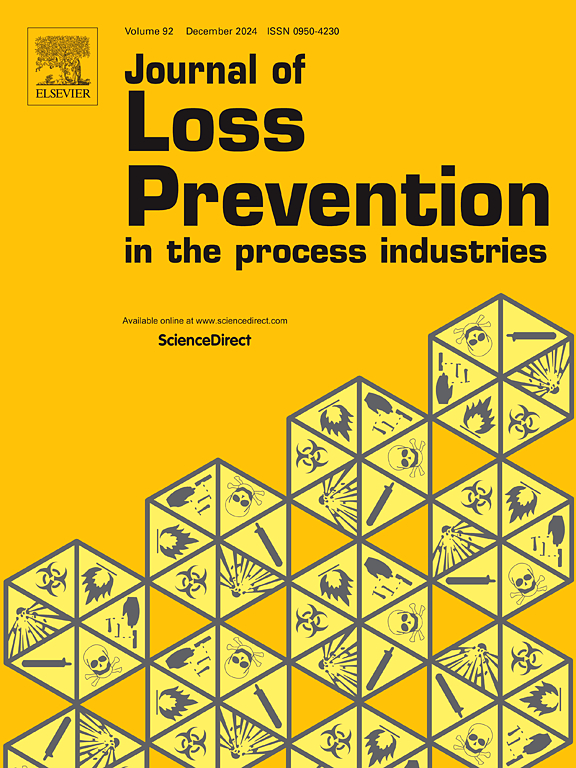Flash point prediction of binary mixtures of ionic liquid and flammable solvent
IF 3.6
3区 工程技术
Q2 ENGINEERING, CHEMICAL
Journal of Loss Prevention in The Process Industries
Pub Date : 2025-03-14
DOI:10.1016/j.jlp.2025.105631
引用次数: 0
Abstract
In chemical processes, ionic liquids (ILs) are commonly applied in mixtures with flammable solvents. To prevent fire and explosion hazards, flammability data regarding these mixtures are required, but these data are lacking in the literature. Moreover, no flash point prediction models have been developed for IL + solvent mixtures. This study developed a model to estimate the flash point of binary mixtures of ILs with flammable solvents. The model was developed based on fundamental theories of the flash point of mixtures and the contribution of IL decomposition to flammability. The proposed model was validated against empirical measurements of the flash points of mixtures of [C6mim][Cl] + methanol/ethanol and [Emim][EtSO4] + methanol/ethanol. Because the model includes the contribution of IL decomposition to flammability, the required activation energy for IL decomposition was estimated from the initial mass loss rate, which was obtained using thermogravimetric analysis. The model predictions agreed well with the empirical data for mixtures with various IL content. The flash point deviations were 5.2–8.3 °C for estimations of solvent nonideality by non-random two-liquid (NRTL) model; this was considered accurate for the wide flash point ranges of the studied mixtures of 142.2–165.4 °C. However, the deviation was large (18.4 °C) for [C6mim][Cl] + ethanol when the NRTL binary interaction parameters from Carvalho et al. (2013)were used. For mixtures with low IL content and flash points well below the IL flash point, a previously developed binary aqueous–organic solution model also accurately describes the flash point.
离子液体与易燃溶剂二元混合物闪点预测
在化学过程中,离子液体通常与易燃溶剂混合使用。为了防止火灾和爆炸危险,需要有关这些混合物的可燃性数据,但这些数据在文献中缺乏。此外,还没有开发出IL +溶剂混合物的闪点预测模型。本研究建立了一个模型,以估计二元混合物的闪点与可燃溶剂。该模型是基于混合物闪点的基本理论和IL分解对可燃性的贡献而建立的。通过对[C6mim][Cl] +甲醇/乙醇和[Emim][EtSO4] +甲醇/乙醇混合物闪点的实证测量验证了所提出的模型。由于该模型包含了IL分解对可燃性的贡献,因此IL分解所需的活化能是通过热重分析获得的初始质量损失率来估计的。对于不同IL含量的混合物,模型预测与经验数据吻合良好。非随机双液(NRTL)模型估计溶剂非理想性的闪点偏差为5.2 ~ 8.3℃;对于所研究的混合物的闪点范围为142.2-165.4°C,这被认为是准确的。然而,当使用Carvalho等人(2013)的NRTL二元相互作用参数时,[C6mim][Cl] +乙醇的偏差很大(18.4°C)。对于低IL含量和闪点远低于IL闪点的混合物,以前开发的二元水-有机溶液模型也准确地描述了闪点。
本文章由计算机程序翻译,如有差异,请以英文原文为准。
求助全文
约1分钟内获得全文
求助全文
来源期刊
CiteScore
7.20
自引率
14.30%
发文量
226
审稿时长
52 days
期刊介绍:
The broad scope of the journal is process safety. Process safety is defined as the prevention and mitigation of process-related injuries and damage arising from process incidents involving fire, explosion and toxic release. Such undesired events occur in the process industries during the use, storage, manufacture, handling, and transportation of highly hazardous chemicals.

 求助内容:
求助内容: 应助结果提醒方式:
应助结果提醒方式:


